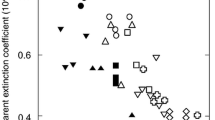Abstract
The leaf lamina ofLavatera cretica L. exhibits a diaphototropic response that discriminates between two opposite, constant vectorial excitations by white light beams whose fluence rates differ by as little as 10% (50 versus 45 μmol·m−2·S−1). The relationship between the response (angular velocity of laminar reorientation) and the fluence-rate ratio is linear. The lamina similarly discriminates between two such excitations by polarized light, one with the electrical vector transverse to the plane of the two beams (θ) and the opposite one with the vector parallel to that plane (⪙). When two such beams were of equal fluence rate, the lamina reoriented towards the ⪙ beam. When the fluence rate of the θ beam was maintained at 50 μmol·m−2·s−1 and that of the ⪙ beam was reduced, the response to the latter (angular velocity of laminar reorientation) was reduced progressively. Further reduction in the fluence rate of the ⪙ polarized beam eventually resulted in reorientation in the opposite direction (towards the θ beam) and the response to the latter increased progressively with the reduction in fluence rate. The equilibrium was at a ⪙/θ ratio of 0.62. Measurements of reflectance of oblique beams of ⪙ and θ polarized light from the upper laminar surface, and of transmittance of such light ghrough the lamina, eliminated the possibility that optical dichroism of the lamina contributed significantly to these results. The implications of this action dichroism to the postulated mechanism of perception of vectorial excitation by these leaves is discussed.
Similar content being viewed by others
Abbreviations
- AI:
-
angle of incidence of the light beam on the laminar surface, in the plane of symmetry of the midvein (0°=vertical)
- BO, TO:
-
light beams directed toward the base and tip of the vein, respectively (negative and positive Al)
- PAR:
-
photosynthetically active radiation (400–700 nm)
References
Haupt, W., Feinleib, M.E. (1979) Introduction. In: Encyclopedia of plant physiology, N.S. vol. 7: Physiology of movements, pp. 1–9, Haupt, W., Feinleib, M.E., eds. Springer, Berlin Heidelberg New York
Jesaitis, A.J. (1974) Linear dichroism and the orientation of thePhycomyces photopigment. J. Gen. Physiol.63, 1–21
Koller, D., Levitan, I., Briggs, W.R. (1985a) The vectorial photoexcitation in solar-tracking leaves ofLavatera cretica (Malvaceae). Photochem. Photobiol.42, 717–723
Koller, D., Levitan, I., Briggs, W.R. (1985b) Components of vectorial photo-excitation in solar-tracking leaves ofLavatera cretica (Malvaceae). Physiol. Vég.23, 913–920
Koller, D., Schäfer, E., Briggs, W.R. (1985c) Action dichroism in the perception of vectorial photo-excitation in solar-tracking leaves ofLavatera cretica. (Abstr.) Eur. Symp. Photomorphogenesis in Plants. Wageningen, The Netherlands
Kortüm, G. (1969) Reflectance spectroscopy. Springer, Berlin Heidelberg New York
Kraml, M. (1986) Light direction and polarization. In: Photomorphogenesis in plants, pp. 237–267, Kendrick R.E., Kronenberg, G.H.M., eds. Martinus Nijhof/Dr. W. Junk, Dordrecht
Marmé, D., Schäfer, E. (1972) On the localization and orientation of phytochrome molecules in corn coleoptiles (Zea mays L.). Z. Pflanzenphysiol.67, 192–194.
Schmidt, W. (1984) The study of basic photochemical and photophysical properties of membrane-bound flavins: the indispensible prerequisite for the elucidation of primary physiological blue light action. In: Blue light effects in biological systems, pp. 81–94, Senger, H., ed. Springer, Berlin Heidelberg New York
Schwartz, A., Koller, D. (1978) The phototropic response to vectorial light in leaves ofLavatera cretica L. Plant Physiol.61, 294–298
Shropshire, W., Jr. (1959) Growth responses ofPhycomyces to polarized light stimuli. Science130, 336
Shropphire, W., Jr., (1979) Stimulus perception. In: Encyclopedia of plant physiology, N.S. vol.7: Physiology of movements, pp. 10–41, Haupt, W., Feinleib, M.E., eds., Springer, Berlin Heidelberg New York
Sundquist, C., Björn, L.O. (1983) Light induced linear dichroism in photoreversibly photochromic sensor pigments. II. Chromophore rotation in immobilized phytochrome. Photochem. Photobiol.37, 69–75
Widell, S., Larsson, C. (1984) Blue light effects and the role of membranes. In: Blue light effects in biological systems, pp. 177–184, Senger, H., ed. Springer, Berlin Heidelberg New York
Author information
Authors and Affiliations
Additional information
Dedicated to the 60thbirth day of Professor Hans Mohr
Rights and permissions
About this article
Cite this article
Koller, D., Ritter, S., Briggs, W.R. et al. Action dichroism in perception of vectorial photo-excitation in the solar-tracking leaf ofLavatera cretica L.. Planta 181, 184–190 (1990). https://doi.org/10.1007/BF02411536
Received:
Accepted:
Issue Date:
DOI: https://doi.org/10.1007/BF02411536




